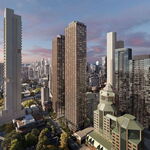To me it all depends on how effectively GO Transit electrification is implemented. If electrified GO within Toronto diverts a significant amount of riders from the TTC onto GO, then the DRL can be built along Queen with closer stop spacing, as it will be acting as a more local line.
If however electrification doesn't get as many riders as hoped, the DRL may need to be built along Wellington in a more express-style subway, with fewer stops.
Until we see for sure how GO electrification will alter trip patterns, planning a route may be a bit premature. I think a lot of the assumptions that people have on here about which route will be best may be turned on their heads once GO actually serves Toronto properly.
If however electrification doesn't get as many riders as hoped, the DRL may need to be built along Wellington in a more express-style subway, with fewer stops.
Until we see for sure how GO electrification will alter trip patterns, planning a route may be a bit premature. I think a lot of the assumptions that people have on here about which route will be best may be turned on their heads once GO actually serves Toronto properly.




